Impact of Changes in Minimum Reflectance on Cloud Discrimination
Abstract
:1. Introduction
2. Materials and Methods
2.1. Satellite Data
2.2. Methods to Choose the 10 Observations
2.3. Rmin Generation Procedure for Cloud and Aerosol Imager
- Separate land and water regions using land/sea flag in CAI L1B products
- Divide region into 1/30° meshes.
- Calculate the minimum TOA reflectance for band 2 for every mesh, treating land and water regions as distinct.
- iv.
- Calculate the minimum and second-minimum TOA reflectance for each mesh using the results of step (ii)
- v.
- Correct for cloud shadows by using the minimum and second-minimum TOA reflectance calculated in step (iv). Cloud shadow correction method, as follows:where R1st and R2nd indicate the minimum and second-minimum reflectance, respectively; R1st,bandn indicates the minimum reflectance of band n [17] Cloud shadow correction is also necessary because cloud shadows remain in Rmin causes to misjudge clear-sky pixels as cloud pixels.
2.4. Comparative Analysis
3. Results
3.1. Comparison among Methods to Choose the 10 Observations
3.2. Comparison among Different Generation Procedures
- Rmin1 of band 2 is lower than Rmin2 of band 2.
- Rmin of band 2 is used for cloud discrimination on land regions. Land pixels occupy most of the test scenes.
4. Discussion
4.1. Differences among Methods Used to Choose the 10 Observations
4.2. Discussion of the Differences of Rmin among Generation Procedures
4.3. Discussion of the Differences of Cloud Discrimination Results among Generation Procedures
4.3.1. Highly Reflective Surface
4.3.2. Snow or Ice
4.3.3. Cloud Remain
4.3.4. The Boundaries between Land and Water
4.3.5. Sun-Glint
5. Conclusions
- To compare Rmin calculated using different methods to choose 10 observations.
- To compare Rmin using different generation procedures and spatial resolutions.
- Rmin2 results had a greater tendency to identify clear sky in comparison with Rmin1 results.
- Rmin2 results had a tendency to overlook optically thin clouds over local highly reflective surfaces.
- Rmin2 results had a tendency to accurately identify local highly reflective surfaces as clouds.
- Ice and snow regions where Rmin1 results misidentified clouds were slightly improved in Rmin2 results.
- For regions with a high cloud cover ratio, Rmin2 results occasionally overlooked optically thin clouds according to cloud remains in Rmin.
- Water regions near the boundary between land and water where Rmin1 results misidentified clouds were improved in Rmin2 results.
- Furthermore, there were almost no differences between Rmin1 results and Rmin2 results in water sun-glint regions.
Author Contributions
Acknowledgments
Conflicts of Interest
References
- NIES GOSAT-2 Project. Available online: www.gosat-2.nies.go.jp (accessed on 26 February 2018).
- Ishida, H.; Nakajima, T.Y. Development of an unbiased cloud detection algorithm for a spaceborne multispectral imager. J. Geophys. Res. 2009, 114, D07206. [Google Scholar] [CrossRef]
- Ishida, H.; Nakajima, T.Y.; Yokota, T.; Kikuchi, N.; Watanabe, H. Investigation of GOSAT TANSO-CAI cloud screening ability through an intersatellite comparison. J. Appl. Meteorol. Climatol. 2011, 50, 1571–1586. [Google Scholar] [CrossRef]
- Ishida, H.; Oishi, Y.; Morita, K.; Moriwaki, K.; Nakajima, T.Y. Development of a support vector machine based cloud detection method for MODIS including the adjustability to various conditions. Remote Sens. Environ. 2018, 205, 390–407. Available online: https://www.sciencedirect.com/science/article/pii/S0034425717305138 (accessed on 26 February 2018). [CrossRef]
- Oishi, Y.; Ishida, H.; Nakajima, T.Y.; Nakamura, R.; Matsunaga, T. The impact of different support vectors on GOSAT-2 CAI-2 L2 cloud discrimination. Remote Sens. 2017, 9, 1236. Available online: https://www.mdpi.com/2072-4292/9/12/1236 (accessed on 26 February 2018). [CrossRef]
- Oishi, Y.; Kamei, A.; Yokota, Y.; Hiraki, K.; Matsunaga, T. Evaluation of the accuracy of GOSAT TANSO-CAI L2 cloud flag product by visual inspection in the Amazon and of the impact of changes in the IFOV sizes of TANSO-FTS. J. Remote Sens. Soc. Jpn. 2014, 34, 153–165. Available online: https://www.jstage.jst.go.jp/article/rssj/34/3/34_153/_article (accessed on 26 February 2018). [CrossRef]
- Oishi, Y.; Hiraki, K.; Yokota, Y.; Sawada, Y.; Murakami, K.; Kamei, A.; Yoshida, Y.; Matsunaga, T. Usability evaluation of GPU for GOSAT-2 TANSO-CAI-2 L2 cloud flag processing. J. Remote Sens. Soc. Jpn. 2015, 35, 173–183. Available online: https://www.jstage.jst.go.jp/article/rssj/35/3/35_173/_article (accessed on 26 February 2018). [CrossRef]
- Oishi, Y.; Nagao, T.M.; Ishida, H.; Nakajima, T.Y.; Matsunaga, T. Preliminary study of a method using the GOSAT-2 CAI-2 cloud discrimination for screening of cloud-contaminated FTS-2 data. J. Remote Sens. Soc. Jpn. 2015, 35, 299–306. Available online: https://www.jstage.jst.go.jp/article/rssj/35/5/35_299/_article (accessed on 26 February 2018). [CrossRef]
- Oishi, Y.; Nakajima, T.Y.; Matsunaga, T. Difference between forward- and backward-looking bands of GOSAT-2 CAI-2 cloud discrimination used with Terra MISR data. Int. J. Remote Sens. 2016, 37, 1115–1126. [Google Scholar] [CrossRef]
- Cano, D.; Monget, J.M.; Albuisson, M.; Guillard, H.; Regas, N.; Wald, L. A method for the determination of the global solar radiation from meteorological satellite data. Sol. Energy 1986, 37, 31–39. Available online: https://www.sciencedirect.com/science/article/pii/0038092X86901040 (accessed on 26 April 2018). [CrossRef]
- Ipe, A.; Clerbaux, N.; Bertrand, C.; Dewitte, S.; Gonzalez, L. Pixel-scale composite top-of-the-atmosphere clear-sky reflectances for Meteosat-7 visible data. J. Geophys. Res. 2003, 108, D19. [Google Scholar] [CrossRef]
- Minnis, P.; Harrison, E.F. Diurnal variability of regional cloud and clear-sky radiative parameters derived from GOES data. Part I: Analysis method. J. Clim. Appl. Meteorol. 1984, 23, 993–1011. [Google Scholar] [CrossRef]
- Popp, C.; Hauser, A.; Foppa, N.; Wunderle, S. Remote sensing of aerosol optical depth over central Europe from MSG-SEVIRI data and accuracy assessment with ground-based AERONET measurements. J. Geophys. Res. 2007, 112, D24S11. [Google Scholar] [CrossRef]
- Algorithm Theoretical Basis Documents on the Processing of GOSAT TANSO-CAI L3 Global Reflectance Products. Available online: https://data2.gosat.nies.go.jp/GosatDataArchiveService/doc/GU/ATBD_CAIL3REF_V1.0_en.pdf (accessed on 26 February 2018).
- Shuttle Radar Topography Mission. Available online: https://www2.jpl.nasa.gov/srtm/ (accessed on 26 February 2018).
- U.S. Geological Survey (USGS) Global Land 1-KM Advanced Very High Resolution Radiometer (AVHRR) Project. Available online: https://lta.cr.usgs.gov/AVHRR (accessed on 26 February 2018).
- Fukuda, S.; Nakajima, T.; Takenaka, H.; Higurashi, A.; Kikuchi, N.; Nakajima, T.Y.; Ishida, H. New approaches to removing cloud shadows and evaluating the 380 nm surface reflectance for improved aerosol optical thickness retrievals from the GOSAT/TANSO-Cloud and Aerosol Imager. J. Geophys. Res. 2013, 118, 13521–13531. [Google Scholar] [CrossRef]

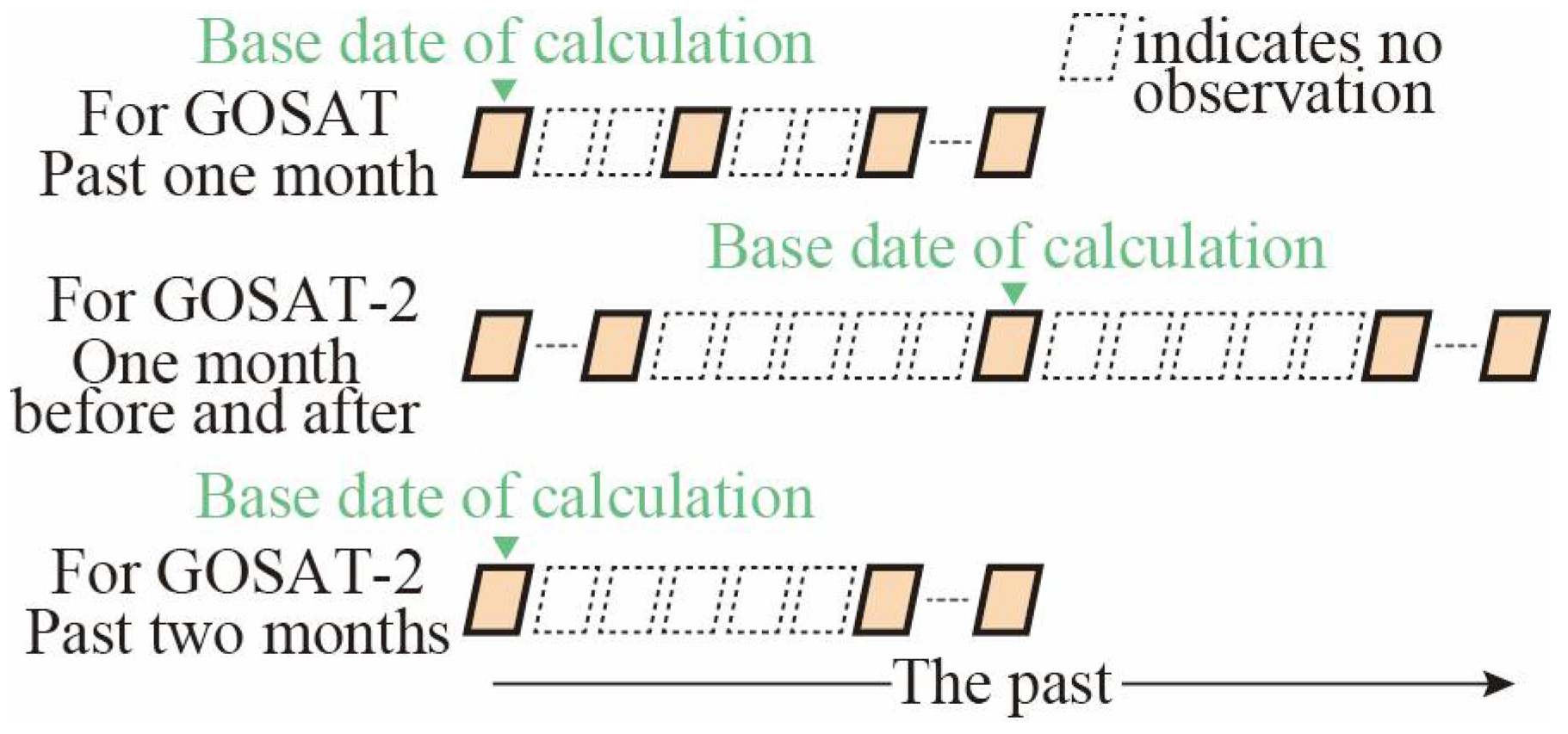
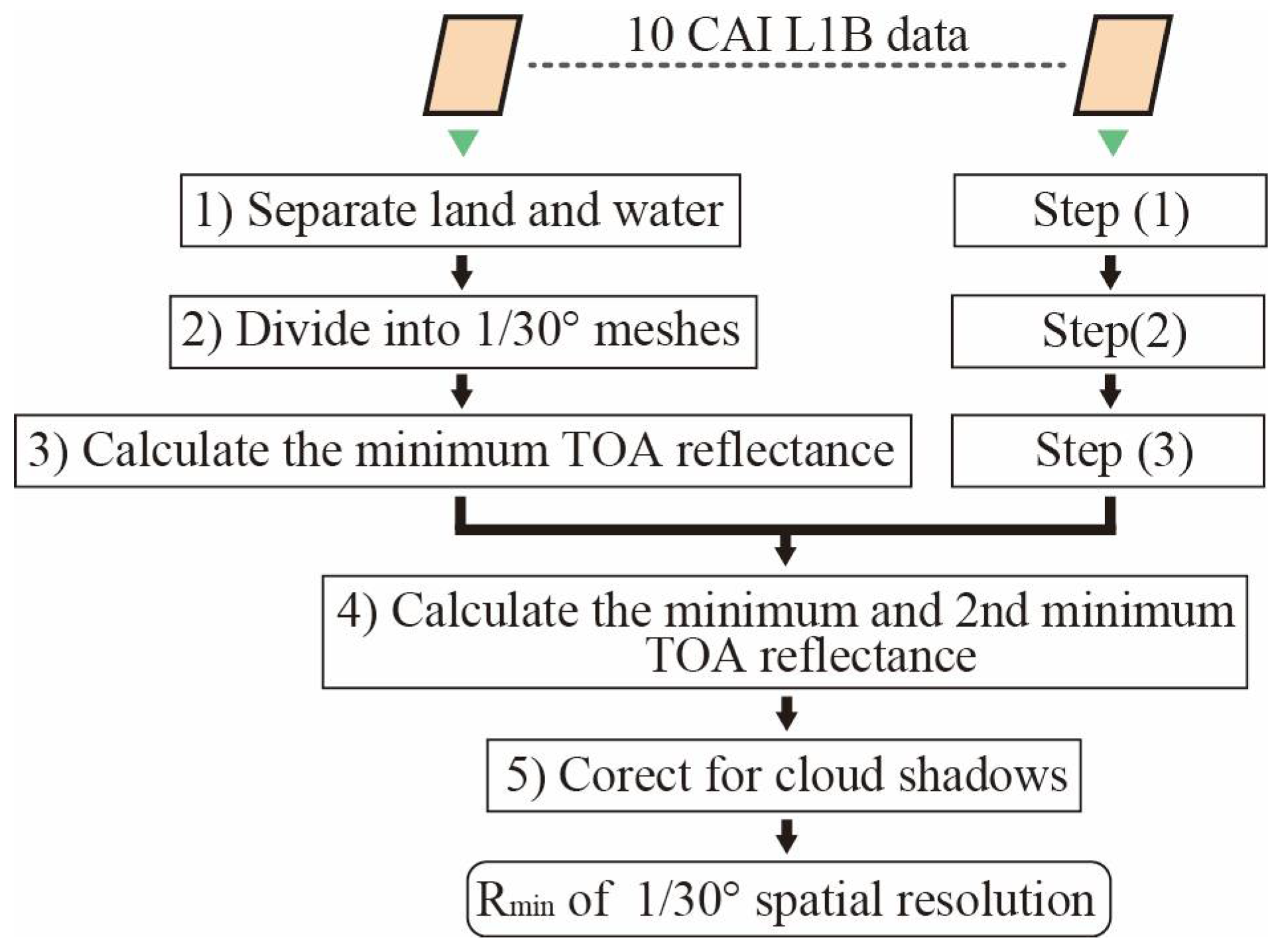
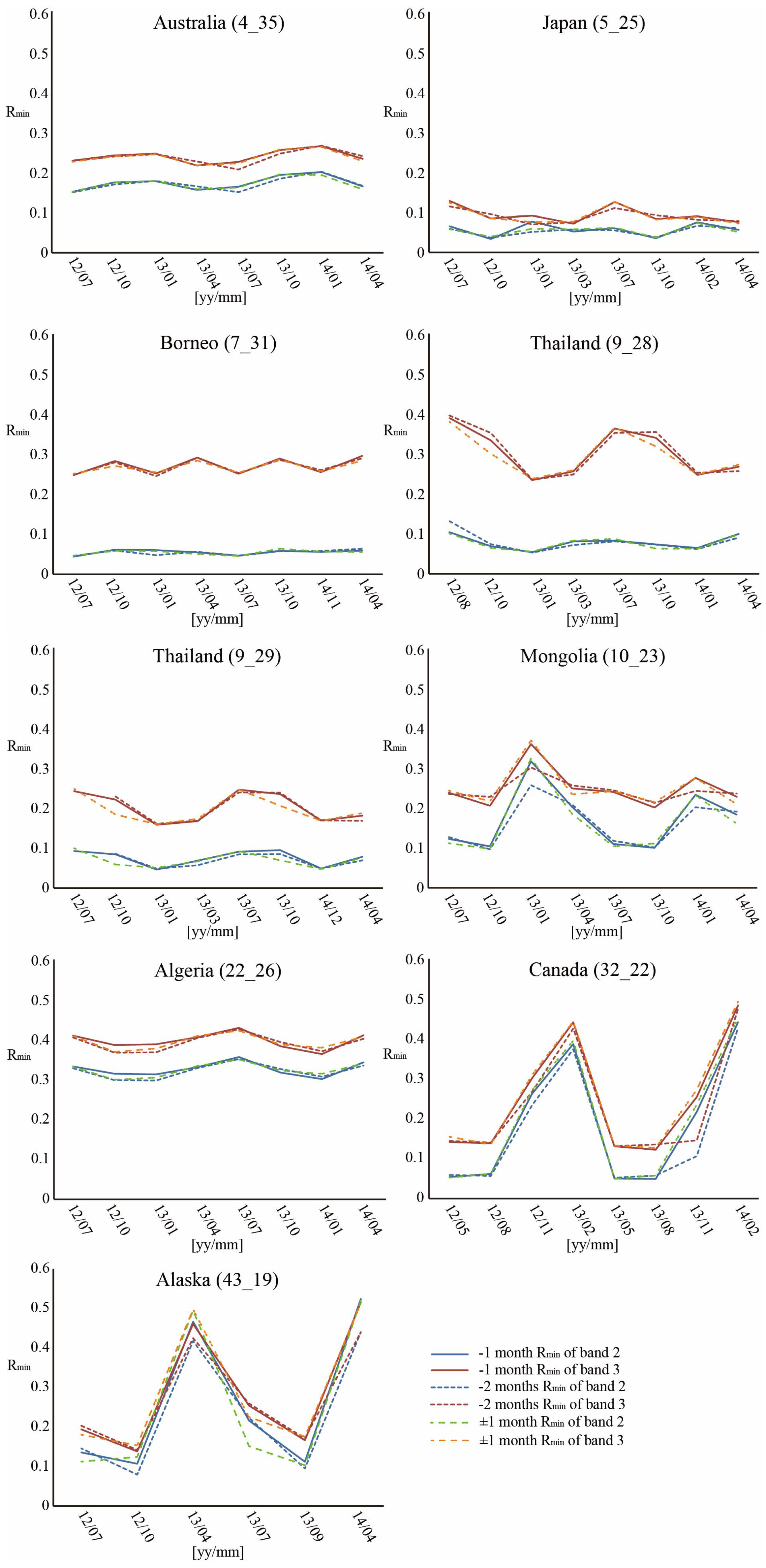
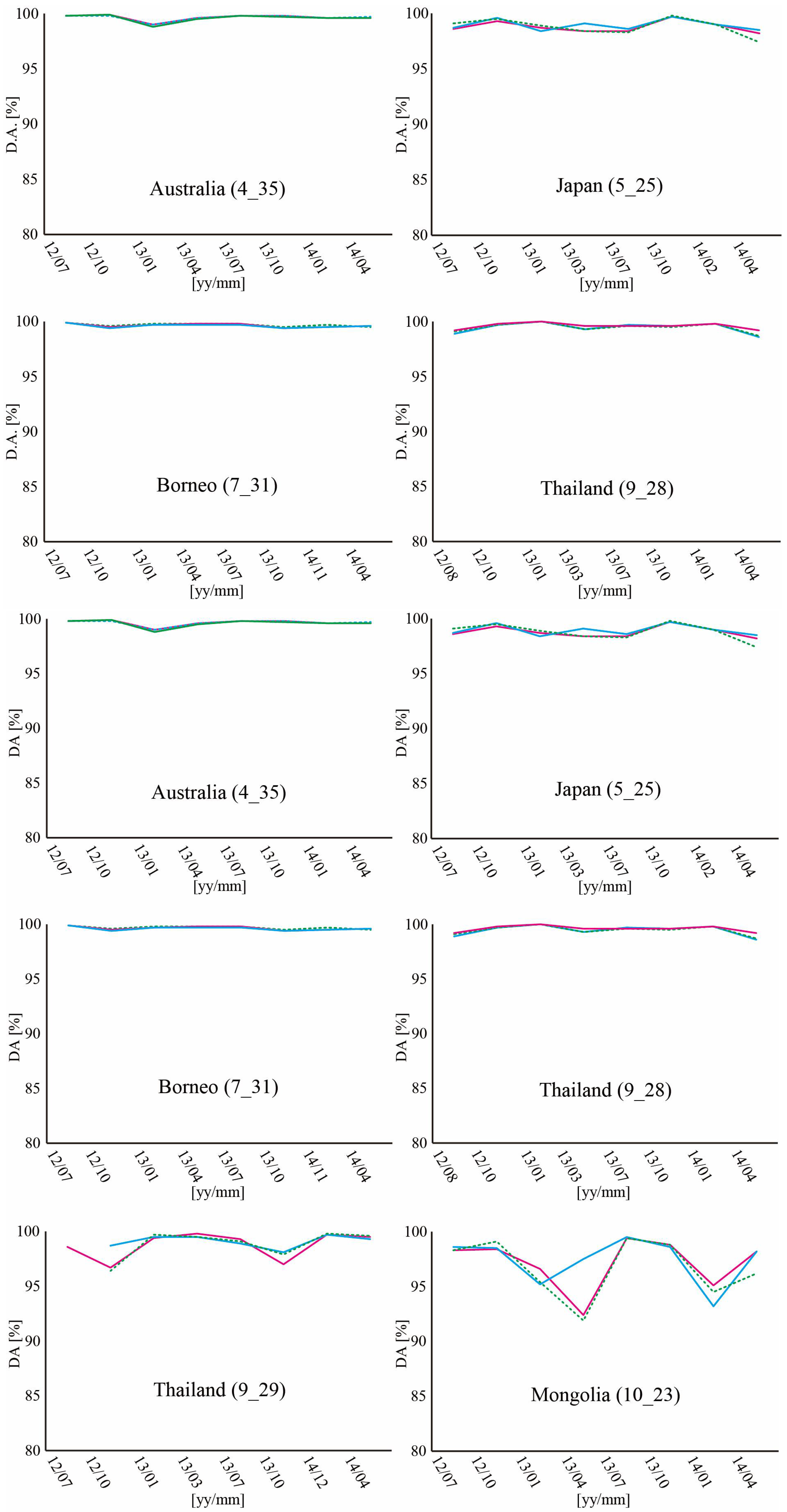
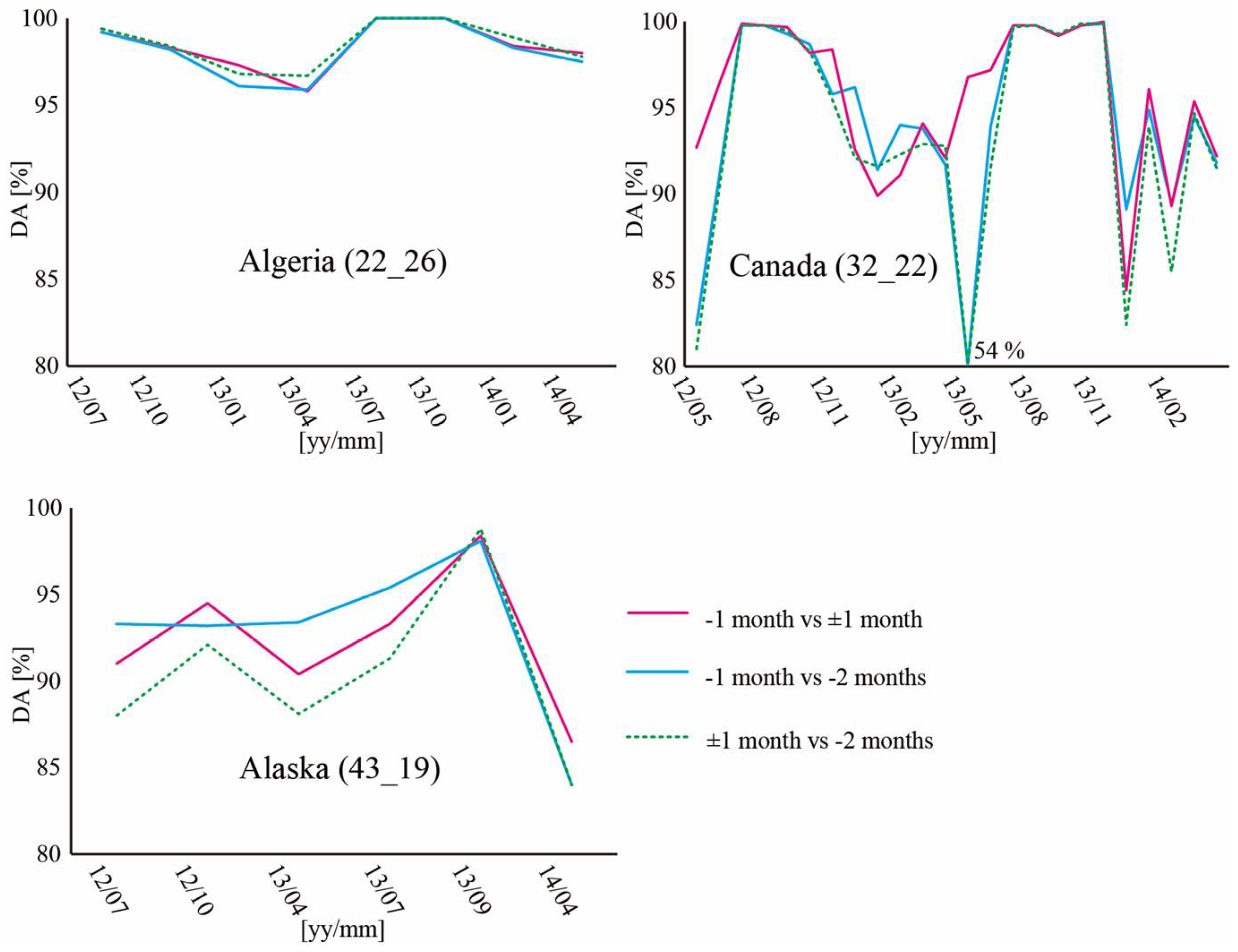
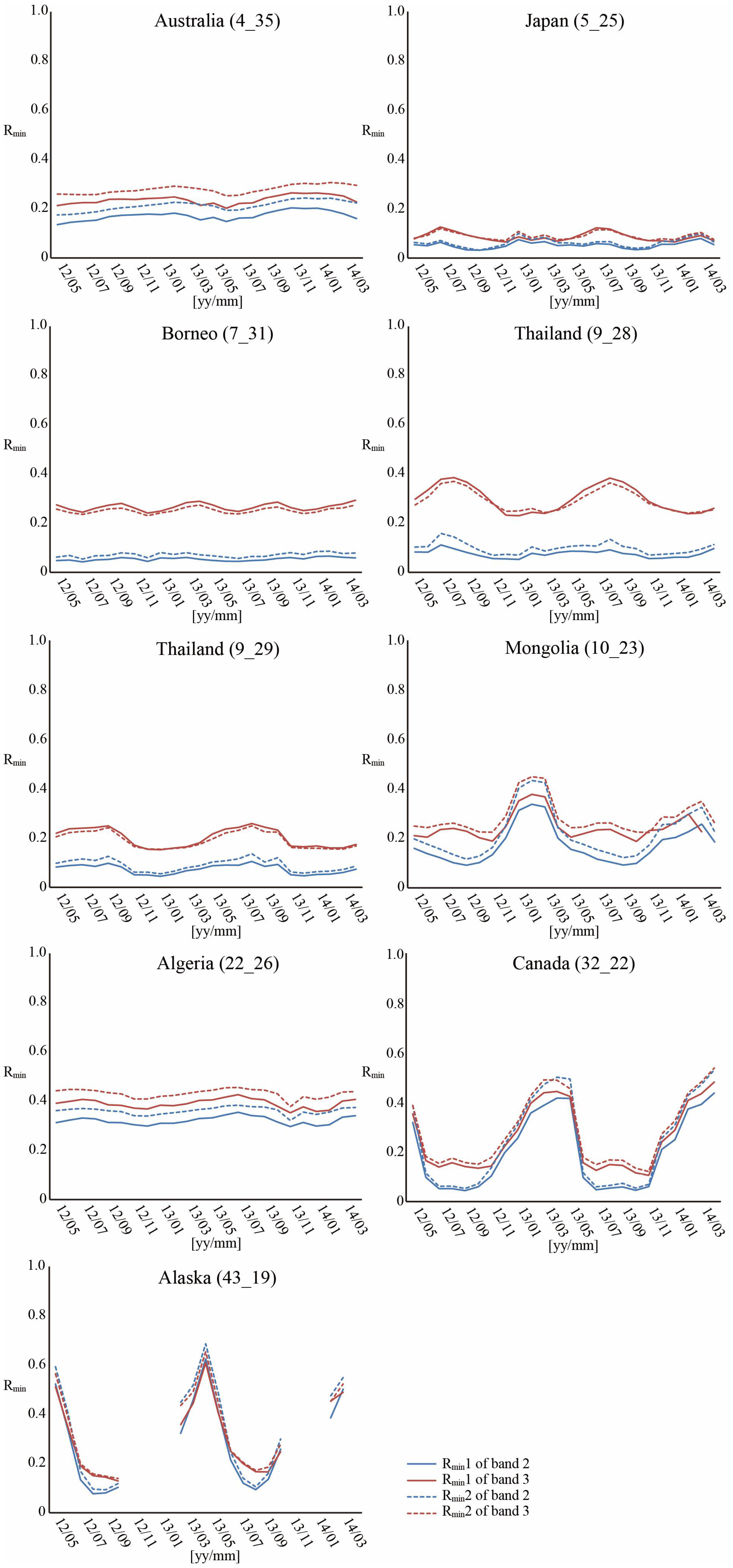
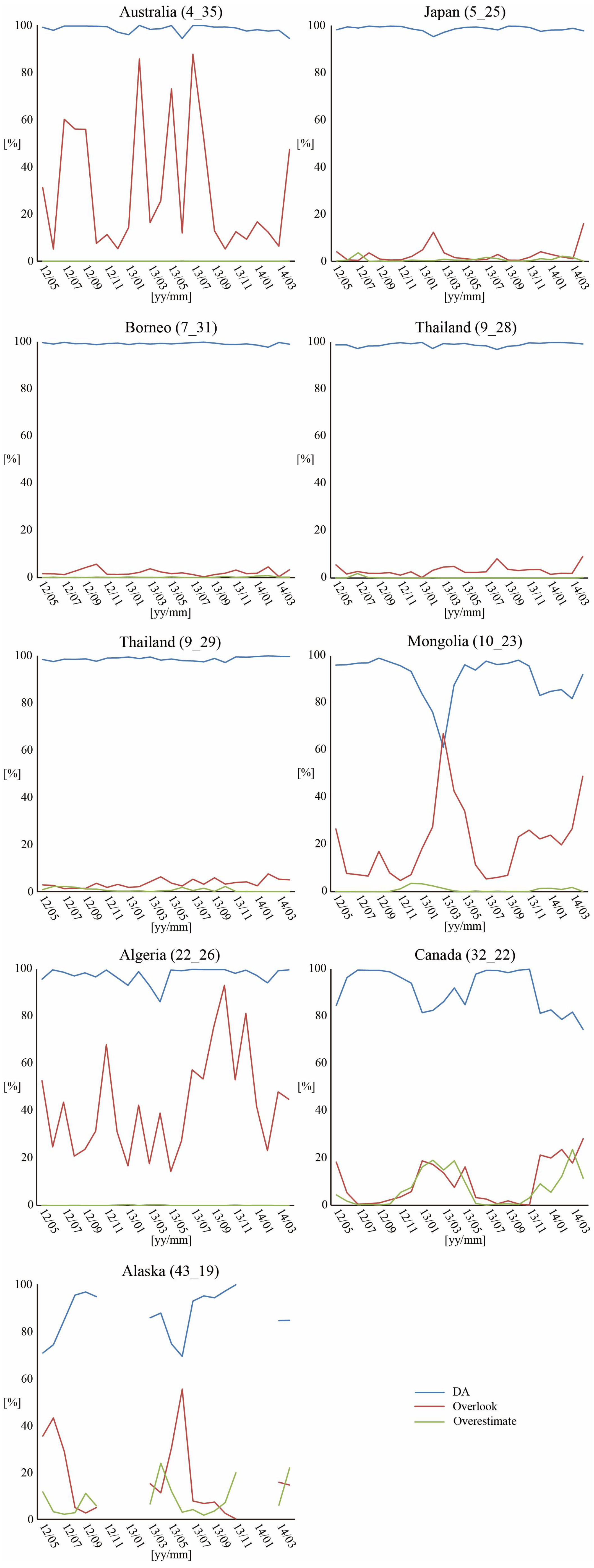
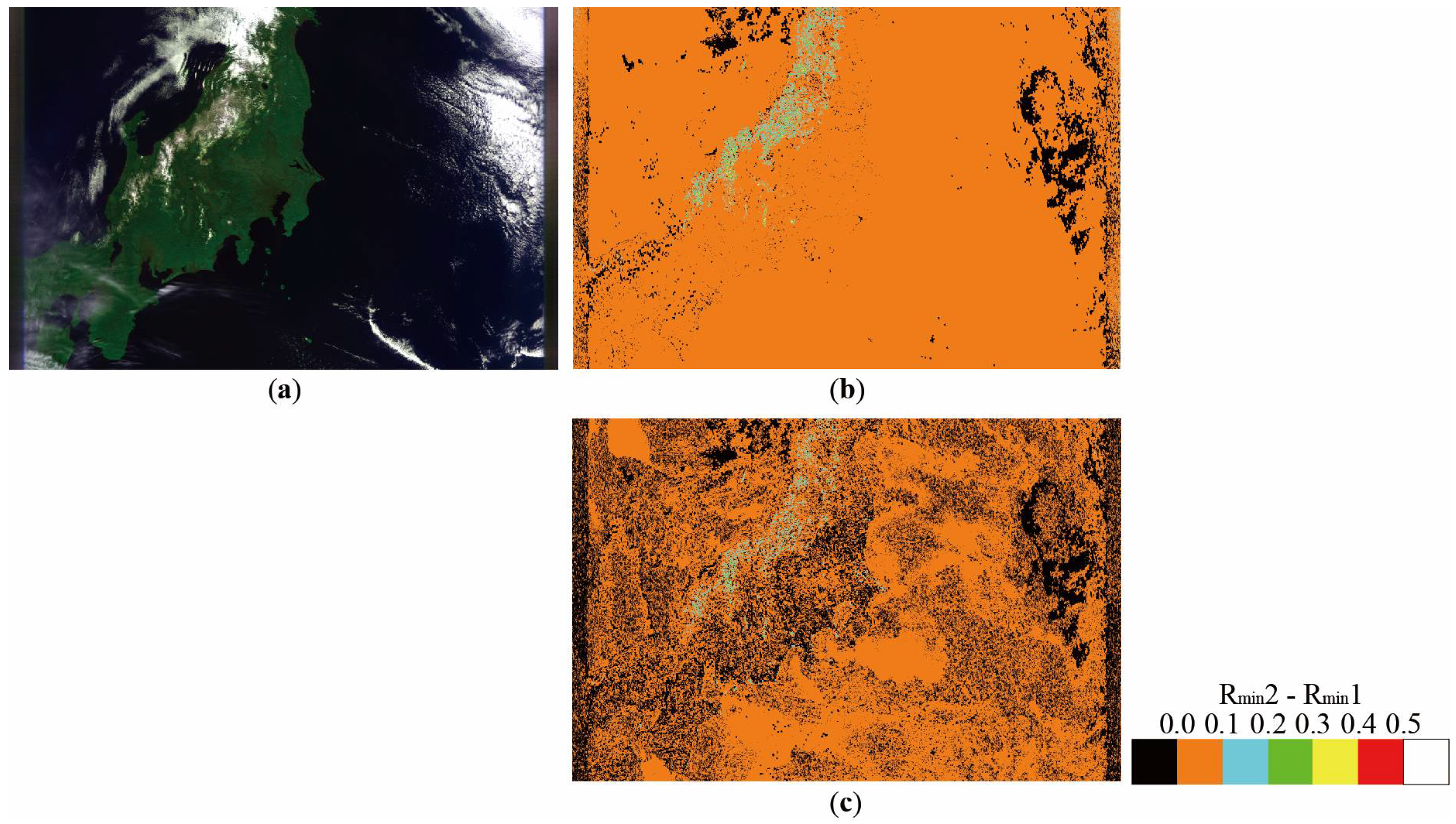

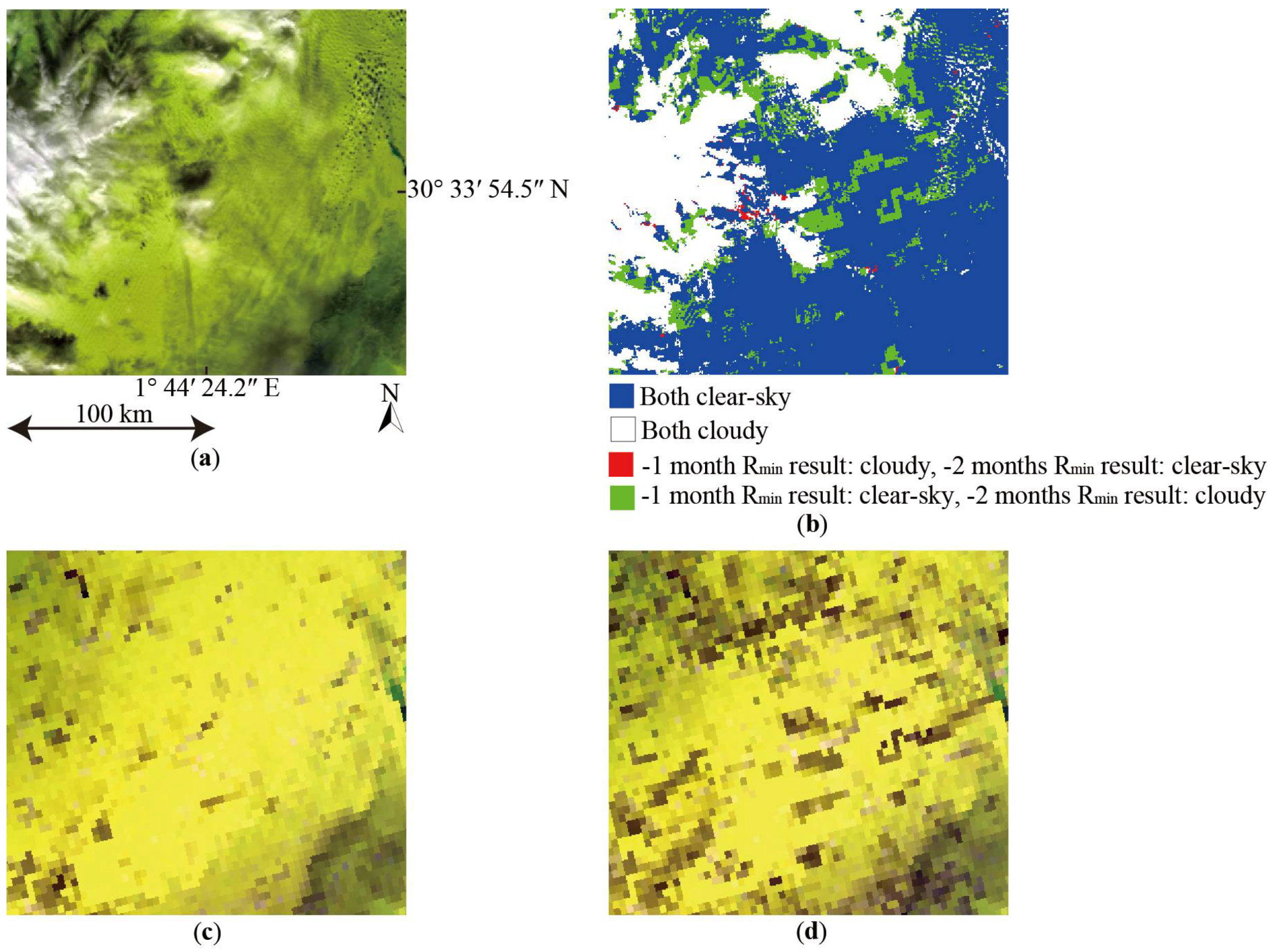
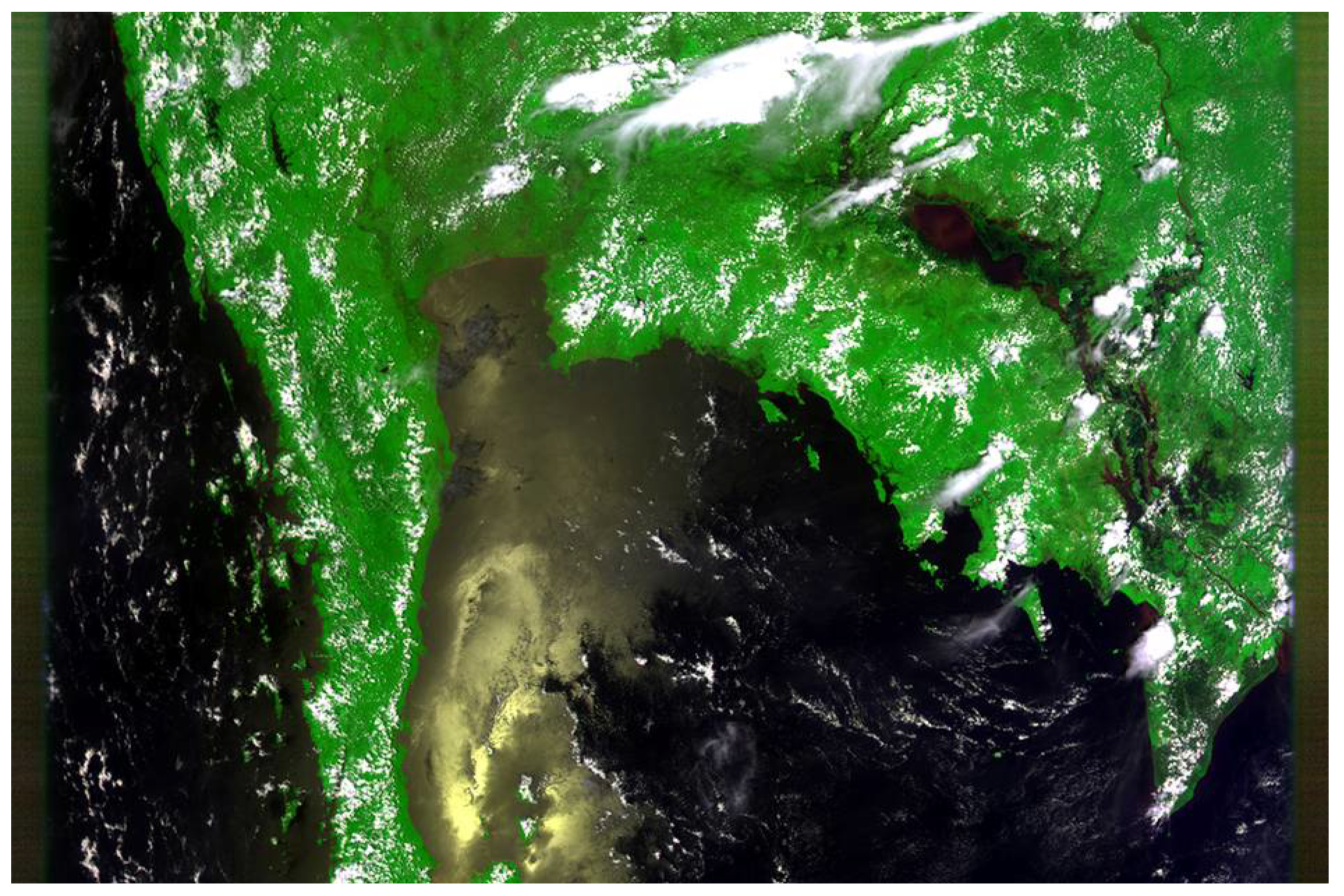
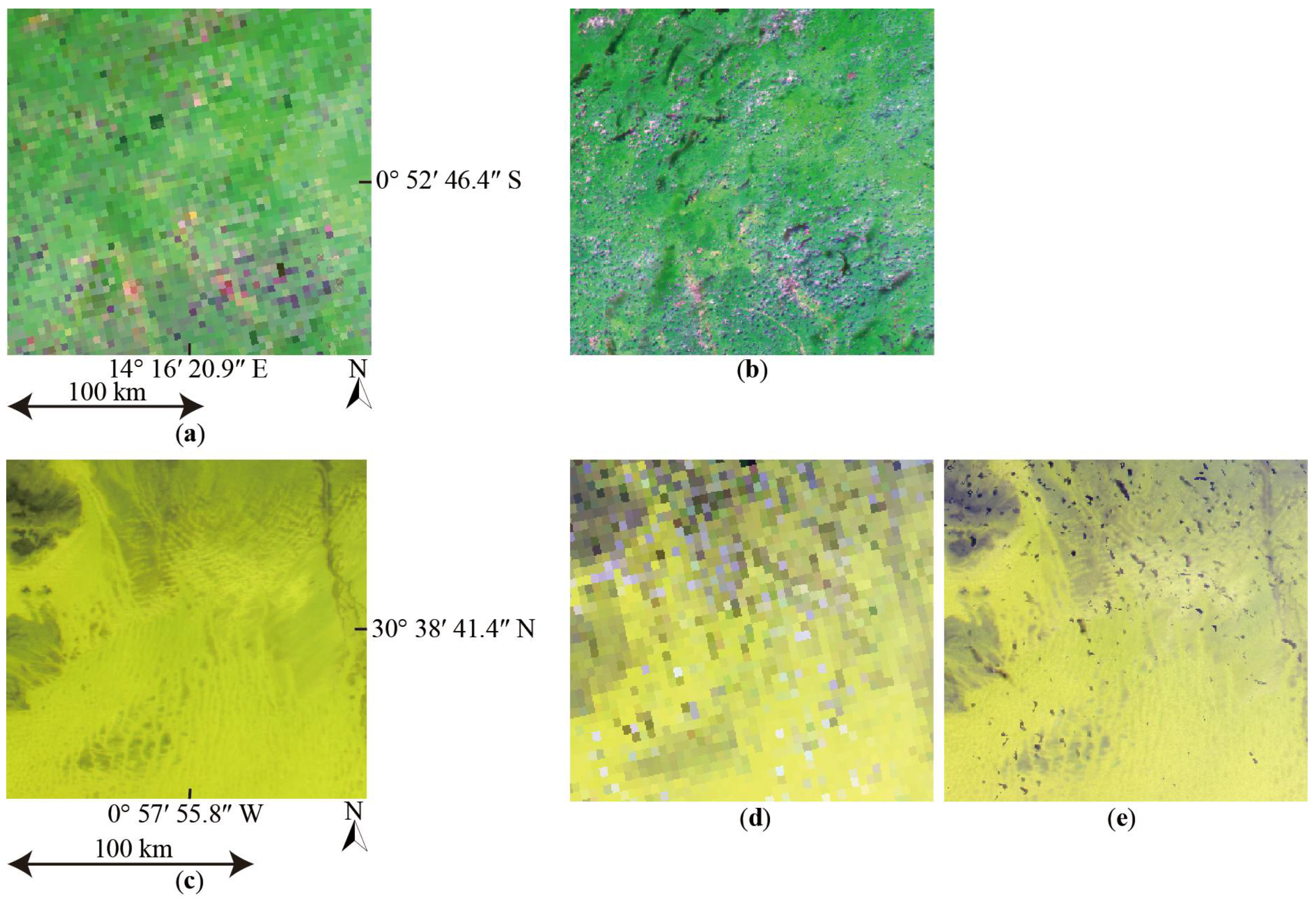
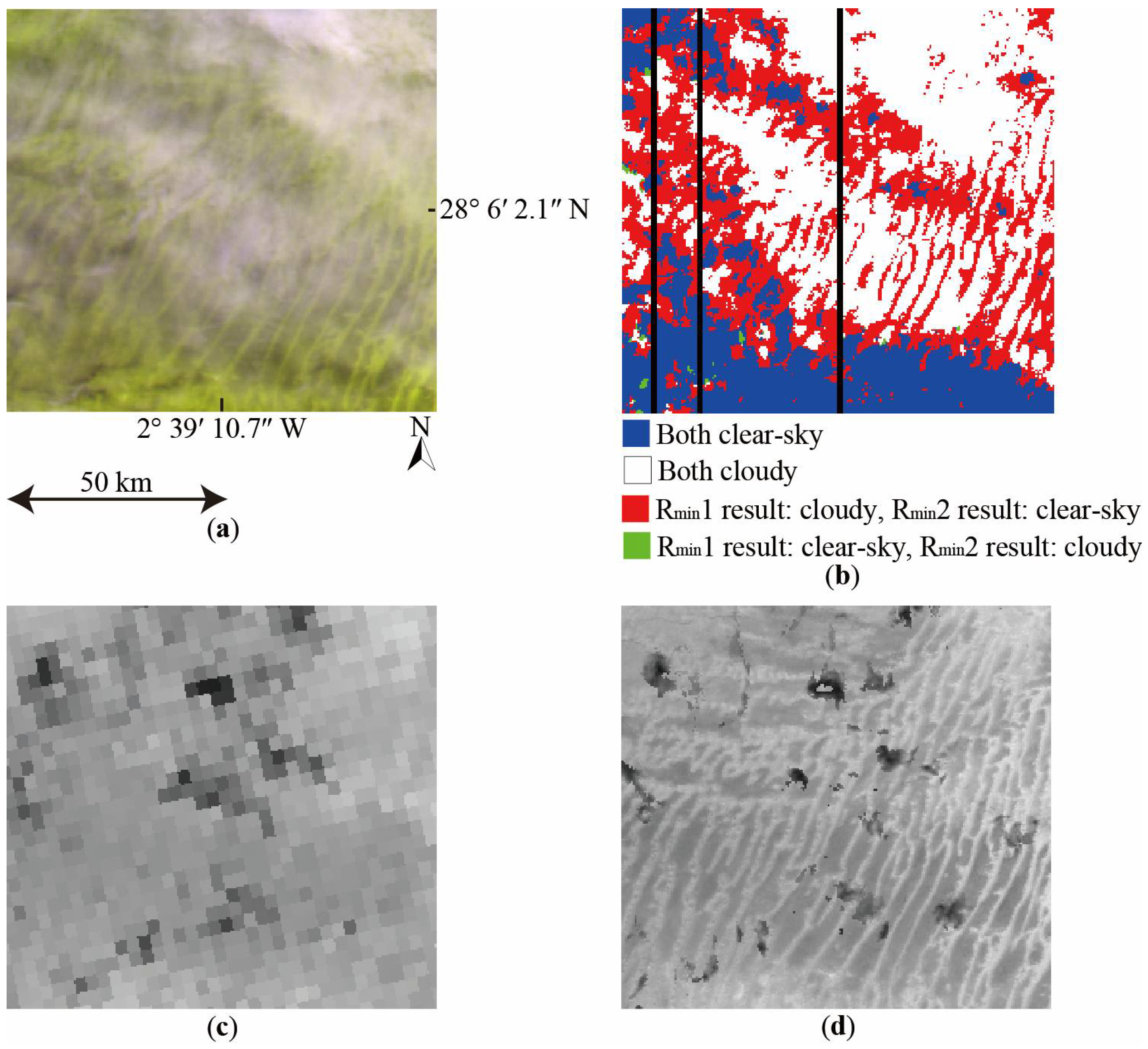
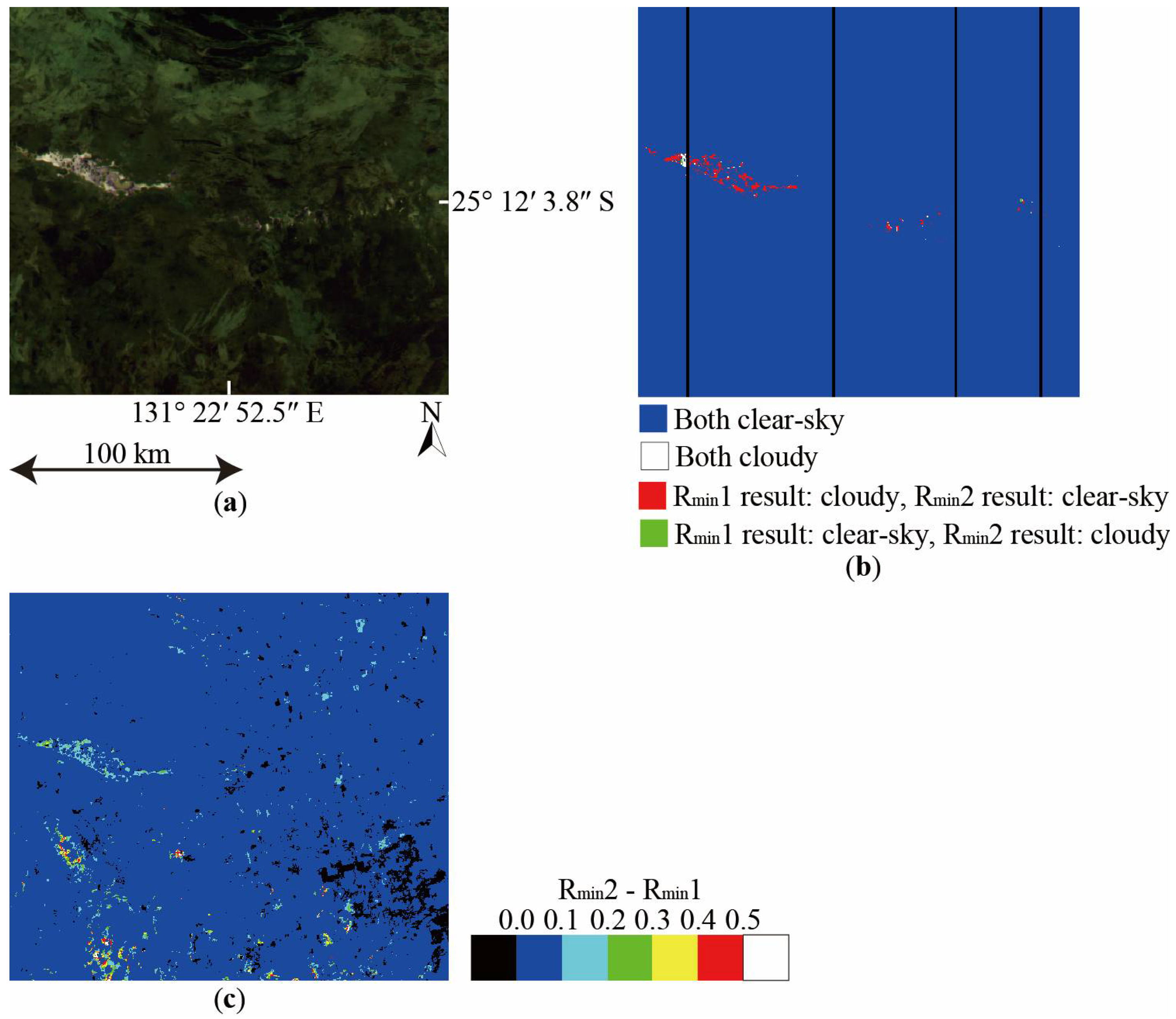
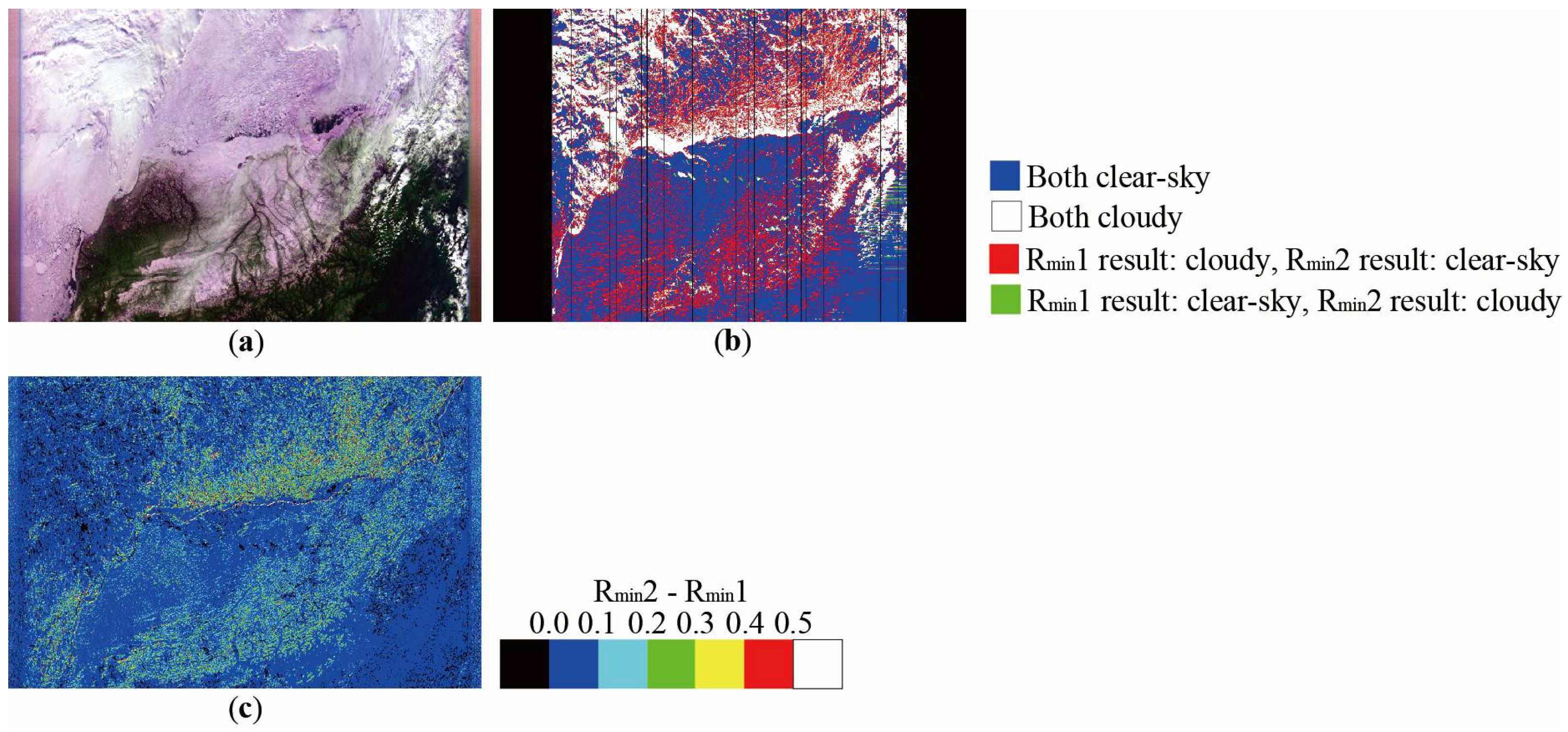
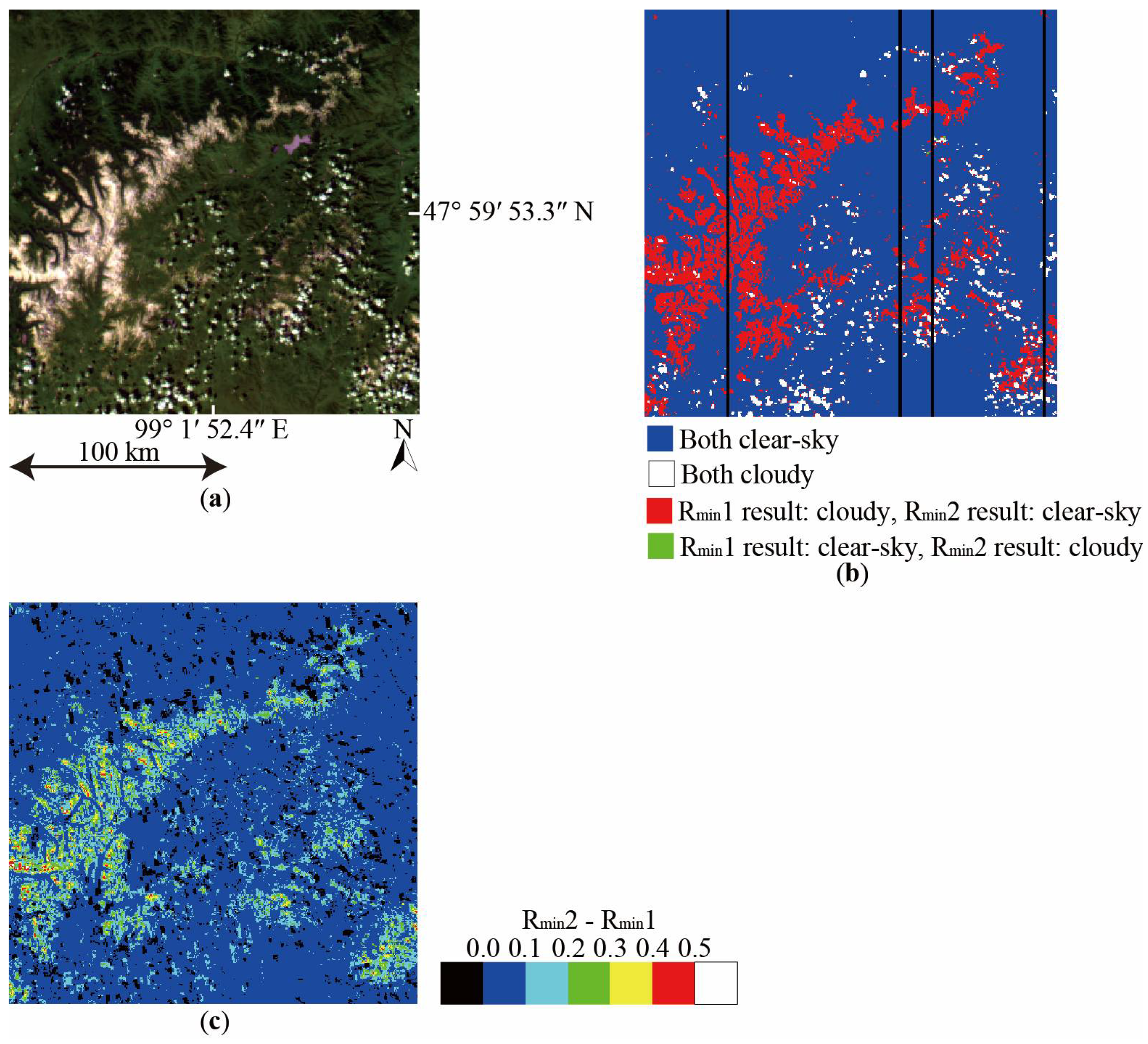

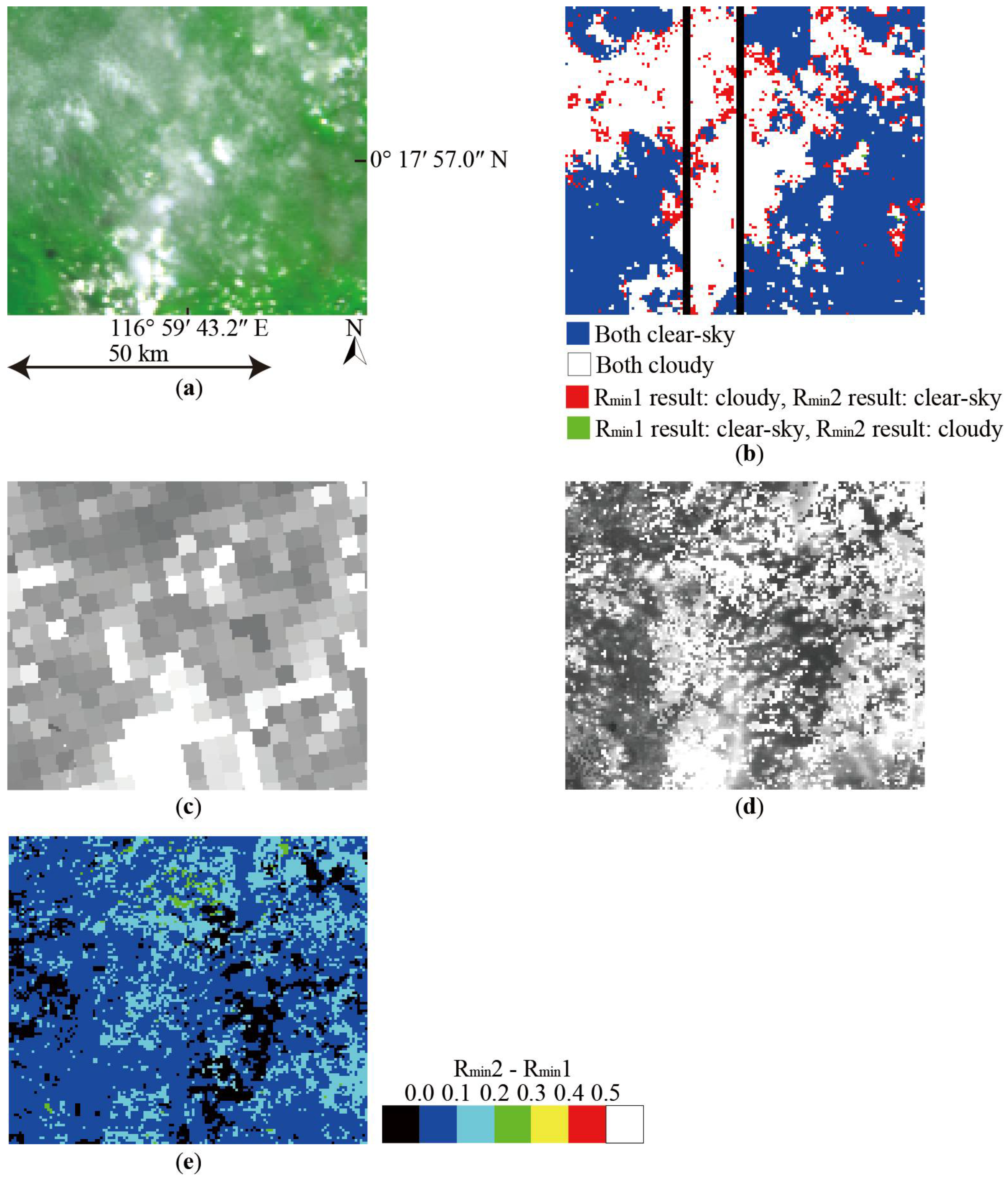


| Location (CAI Path_Frame) | Data Period | Land Cover |
|---|---|---|
| Australia (4_35) | 3 April 2012–3 March 2014 | Open shrublands |
| Japan (5_25) | 1 April 2012–1 March 2014 | Mixed forests |
| Borneo (7_31) | 3 April 2012–3 March 2014 | Evergreen broadleaf forest |
| Thailand 1 (9_28) | 2 April 2012–2 March 2014 | Cropland/natural vegetation |
| Thailand 2 (9_29) | 2 April 2012–2 March 2014 | Cropland/natural vegetation |
| Mongolia (10_23) | 3 April 2012–3 March 2014 | Grasslands |
| Algeria (22_26) | 3 April 2012–3 March 2014 | Barren or sparsely vegetated |
| Canada (32_22) | 1 April 2012–1 March 2014 | Evergreen needleleaf forest |
| Alaska (43_19) | 1 April 2012–1 March 2014 | Open shrublands |
| Specifications of CAI | ||||
| Band | Central Wavelength (nm) | Spatial Resolution (m) | Swath (km) | |
| 1 | 380 | 500 | 1000 | |
| 2 | 674 | |||
| 3 | 870 | |||
| 4 | 1600 | 1500 | 750 | |
| Specifications of CAI-2 | ||||
| Band | Central Wavelength (nm) | Spatial Resolution (m) | View Angle (deg.) | Swath (km) |
| 1 | 343 | 460 | +20 (Forward) | 920 |
| 2 | 443 | |||
| 3 | 674 | |||
| 4 | 869 | |||
| 5 | 1630 | 920 | ||
| 6 | 380 | 460 | −20 (Backward) | |
| 7 | 550 | |||
| 8 | 674 | |||
| 9 | 869 | |||
| 10 | 1630 | 920 | ||
© 2018 by the authors. Licensee MDPI, Basel, Switzerland. This article is an open access article distributed under the terms and conditions of the Creative Commons Attribution (CC BY) license (http://creativecommons.org/licenses/by/4.0/).
Share and Cite
Oishi, Y.; Sawada, Y.; Kamei, A.; Murakami, K.; Nakamura, R.; Matsunaga, T. Impact of Changes in Minimum Reflectance on Cloud Discrimination. Remote Sens. 2018, 10, 693. https://doi.org/10.3390/rs10050693
Oishi Y, Sawada Y, Kamei A, Murakami K, Nakamura R, Matsunaga T. Impact of Changes in Minimum Reflectance on Cloud Discrimination. Remote Sensing. 2018; 10(5):693. https://doi.org/10.3390/rs10050693
Chicago/Turabian StyleOishi, Yu, Yoshito Sawada, Akihide Kamei, Kazutaka Murakami, Ryosuke Nakamura, and Tsuneo Matsunaga. 2018. "Impact of Changes in Minimum Reflectance on Cloud Discrimination" Remote Sensing 10, no. 5: 693. https://doi.org/10.3390/rs10050693
APA StyleOishi, Y., Sawada, Y., Kamei, A., Murakami, K., Nakamura, R., & Matsunaga, T. (2018). Impact of Changes in Minimum Reflectance on Cloud Discrimination. Remote Sensing, 10(5), 693. https://doi.org/10.3390/rs10050693







